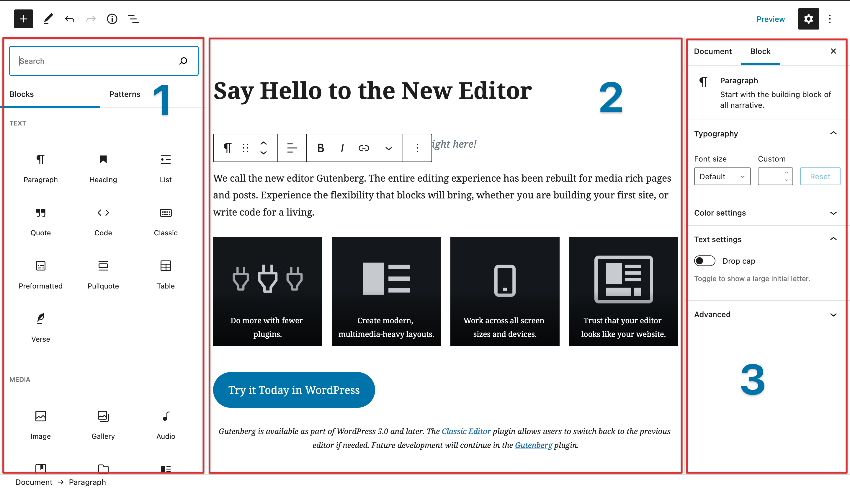
The WordPress Gutenberg block was launched in December 2018 with the goal to facilitate full site editing. Also called the WordPress block editor this plugin follows a block based approach and allows easy manipulation of the content. The special thing about this plugin is every element in the content is a block. For example, each paragraph is a block, each image is a block, each video is a block, etc. You get the picture!
This method can be used to create more complex layouts and group multiple blocks together to create a cohesive section. This plugin isn’t just a content editor but offers many more advantages. Its main aim is to orchestrate a full site editing. For example, if you want to edit your headers the Gutenberg block comes in handy as you will be able to design custom headers.
The Pros of Gutenberg Block
- This plugin is a unified block system
- Its design backgrounds are very visual
- Gutenberg is the core of WordPress hence its output code will be cleaner and lighter. Design built using the Gutenberg block will load faster compared to the same design made with a page builder.
- Gutenberg is also very flexible making it a hit amongst users
- Since Gutenberg is the core of WordPress there will be no compatibility issues either.
These are the pros of the Gutenberg block which is touted to be a step ahead of the classic editor. As I have mentioned earlier in this post the Gutenberg block aims to be a full site editor.
Gutenberg Block – Full site editing
Full site editing means not only having control over the body of your content but also having control over the header, footer, backgrounds and themes of your content. So, you will be able to edit all parts of your site and not just a few sections.
This happens with the gradual increase in features. For example, In WordPress 5.8, the block editor will have the feature to manage block widgets giving you more control. Access to some of the theme based blocks like Site logo, Navigation, Query Loop will be granted.
This block has become the main constant of WordPress and has continually evolved with each version having its bugs fixed in the Gutenberg Block.
Why Use Gutenberg Blocks?
Gutenberg is the new content editing system that comes built into WordPress. Introduced in WordPress 5.0, Gutenberg moves WordPress editing to a block-based workflow. This allows for more streamlined creation of rich content layouts. There are several key reasons why using Gutenberg blocks can benefit your WordPress site:
More Intuitive Editing Experience
The block-based editor allows you to build pages by stacking different content blocks. This makes the editing process more visually intuitive. You can easily drag and drop blocks into your preferred positions. Some key advantages to this system:
- Easier to visualize content layout
- Streamlines the editing workflow
- Provides a more user-friendly editing environment
Table 1: Key Benefits of Block Editor
| Benefit | Description |
| Easier manipulation | Drag, drop, align blocks in desired structure |
| Faster layout changes | Quickly move blocks without copying content |
| Better collaboration | Multiple editors can work on different blocks |
More Content Flexibility: Gutenberg introduces new content blocks that were not available in the classic editor. This includes blocks like columns, media blocks, buttons, etc. With many blocks to choose from, you have more flexibility in customizing layouts.
Some popular Gutenberg blocks include:
- Columns – Create multi-column layouts easily
- Media blocks – Embed videos, images, audio files
- Buttons – Highlight calls-to-action
- Lists – Consistent looking bullet point and numbered lists
- Quotes – Stylized pull quotes to highlight passages
Easier Customization: The block editor makes it easier to customize the design of your content. For example, formatting options are now built directly into the individual blocks. This allows for template and styles to be adjusted on a granular block-level.
Gutenberg constantly evolves and improves
Developers are focusing on the Gutenberg block and each major version has new features and enhancements added to it leading to its evolution. There have been improvements to the user interface, accessibility, drag-and-drop and other usability issues.
The primary goal of this plugin is to help users create better, richer content and enhance their editing experience. So, this plugin allows you to break up a post or blog or its contents into various blocks. This plugin also has a third party block directory that allows you to test and install third party word press blocks within the WordPress block editor.
This directory is built right into the block editor letting you install new block types to your site without leaving the editor. This is denoted by the + icon present on the top left of the page.
Conclusion – The Gutenberg block is here to stay
In case you were more comfortable with the previous editor the classic editor, then I have got some bad news for you. The Gutenberg block is here to stay. The classic editor makes it possible for users to use plugins that extend the screen, add Meta boxes, etc. but the WordPress team is vouching for the Gutenberg block.
According to WordPress, the classic editor will be retained by them till 2022. As the Gutenberg block editor constantly evolves and enables full site editing giving you more control it will eventually phase out the classic editor and become the central focus of WordPress.






